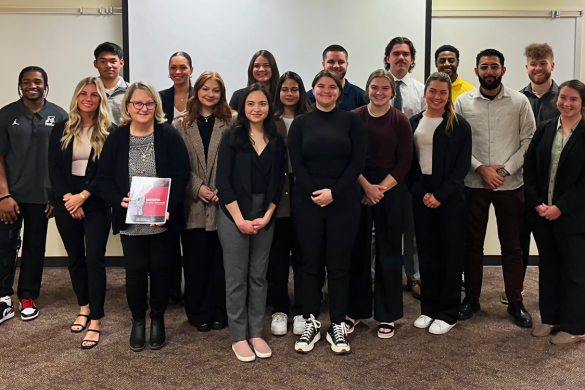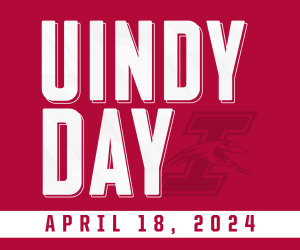
Professor of History and Political Science James Fuller gestures to a map depicting which party won each state in the 1872 election in his lecture on Sept. 20. Photo by Zoë Berg
Professor of History and Political Science James Fuller gave a lecture on Sept. 20, titled “How to Steal a Presidential Election: The Contested Election of 1876.” The lecture focused on the candidates and events surrounding the 1876 election, but could relate to the 2016 election.
“This is a lecture about history, but it’s also relevant to our time,” Fuller said.
Fuller began first by explaining the four major issues of the 1876 election. He said there were deep divisions after the Civil War, a financial panic, corruption and more corruption. At the time, he said the Republican Party was similar to the Democratic Party of today, and vice versa. The Republican Party was deeply divided, and each section had a candidate they preferred, according to Fuller. At the time, Ulysses S. Grant was president.
“For several years—[18]73, [18]74 and into [18]75—it looked like Grant would seek a third term,” Fuller said. “And he would be the first one to do this, but he didn’t want to break the precedent. He was worried.”
Fuller said part of the reason that Grant did not run again was that there was a lot of corruption within his administration. Once Grant was completely out of the running, the doors were open to a lot of new Republican candidates. Fuller said it was a lot like the way the 2016 presidential election started, with so many different Republican candidates. The main Republican candidate was Governor of Ohio Rutherford B. Hays. Fuller said Hays did not act like he would win. Instead, he set himself up as everyone’s second choice.
Fuller said the Republicans would tell people, “‘If your man doesn’t get enough votes on the first ballot, the second ballot, the third ballot, then vote for Hays.’ And that’s what they did. He got elected on the seventh ballot.”
The Democrats were struggling to gain popularity and had not had a president elected from their party since James Buchanan in 1856, according to Fuller. He said Buchanan was the worst president ever and always would be.
“Even if Trump is elected, it will be harder for him to go lower than James Buchanan,” Fuller said. “Even if Hillary is bad, she won’t be worse than James Buchanan. Everyone agrees he’s the worst.”
The Democrats were gaining popularity with their candidate Governor of New York Samuel J. Tilden. Fuller said he was the Rand Paul of the election of 1876 and a classical liberal who believed in limited government and laissez-faire. Tilden ended up winning the nomination on the second ballot, after he beat out Thomas Hendricks who was popular among white southerners.
Fuller said a common phrase during the election was to pick “the lesser of two evils,” which he said is also common this year, along with some of the same issues.
“I think that it [the election] is very polarized, both then and now, not with the same issues necessarily but at a point where many of us don’t trust the candidates in the other party,” Fuller said. “And people think if the other candidate wins, the country will be destroyed.”
Those thoughts were also present in the election of 1876, according to Fuller. When the time came to vote, Tilden won the election by popular vote, but as Fuller pointed out, the popular vote does not decide an election, the Electoral College does. Hays won the election and became president because he got one more vote than Tilden from the Electoral College. This caused the Democrats to say the Republicans stole the election, but Republicans thought something else.
According to Fuller, the Republicans thought the election was theirs and that the Democrats had tried to steal it by intimidating African-American voters to change their vote or not to vote. So the Republicans thought they were just stealing the election back. Ultimately there is more than one way to steal an election. Fuller said the Republicans pushed their candidate through and found a way to take the Electoral College by one vote, but the Democrats had a more violent strategy.
“You’ve got to have a lot of guts,” he said. “You’ve got to be violent and intimidate people, use guns and kill people and ride around at night.”
Freshman psychology pre-physical therapy major Ashley Gray said she learned a lot from the lecture and especially enjoyed hearing about how people talked about the candidates during the election of 1876.
“It was cool that it all came together,” Gray said. “I think that it related to the election now, and it was strange and ironic.”
Junior political science major Erin O’Riley has been to previous lectures by Fuller and enjoyed them. O’Riley said Fuller did an excellent job speaking and made the lecture very interesting.
“I really liked how he talked about the Electoral College,” O’Riley said. “It’s a salient issue right now because people are scared they have too much power.”
The history and political science department will host another event on Oct. 6 at 7:30 p.m. in the Student Center Schwitzer Room 010. The event is titled, “What Can You Do with a Liberal Arts Major?” and will feature alumni from the department who give advice about what students can do with a degree in that field.






